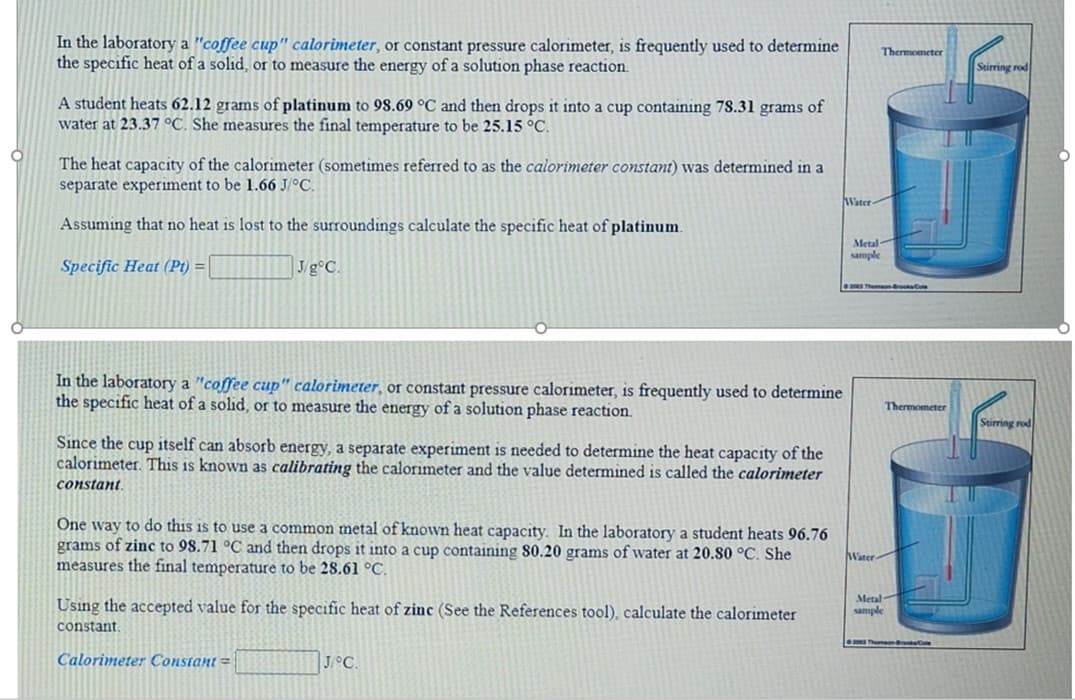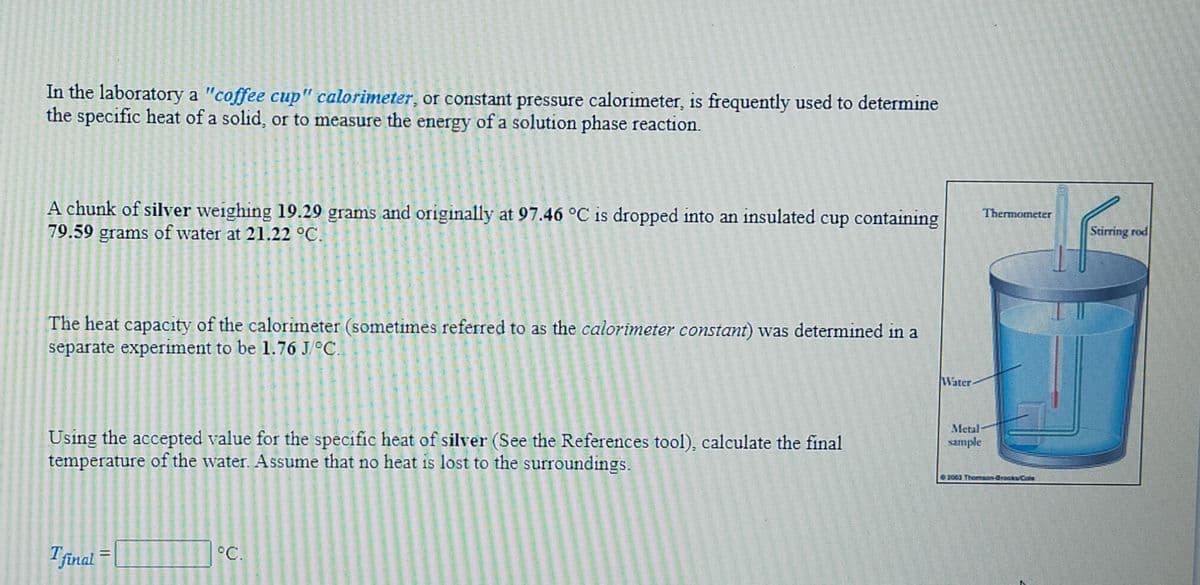In the laboratory a "coffee cup" calorimeter, or constant pressure calorimeter, is frequently used to determine the specific heat of a solid, or to measure the energy of a solution phase reaction. Thermometer Stirring rod A student heats 62.12 grams of platinum to 98.69 °C and then drops it into a cup containıng 78.31 grams of water at 23.37 °C. She measures the final temperature to be 25.15 °C. The heat capacity of the calorimeter (sometimes referred to as the calorimeter constant) was determined in a separate experiment to be 1.66 J/°C. Water Assuming that no heat is lost to the surroundings calculate the specific heat of platinum. Metal sample Specific Heat (Pt) = Jg°C.
In the laboratory a "coffee cup" calorimeter, or constant pressure calorimeter, is frequently used to determine the specific heat of a solid, or to measure the energy of a solution phase reaction. Thermometer Stirring rod A student heats 62.12 grams of platinum to 98.69 °C and then drops it into a cup containıng 78.31 grams of water at 23.37 °C. She measures the final temperature to be 25.15 °C. The heat capacity of the calorimeter (sometimes referred to as the calorimeter constant) was determined in a separate experiment to be 1.66 J/°C. Water Assuming that no heat is lost to the surroundings calculate the specific heat of platinum. Metal sample Specific Heat (Pt) = Jg°C.
Introduction to Chemical Engineering Thermodynamics
8th Edition
ISBN:9781259696527
Author:J.M. Smith Termodinamica en ingenieria quimica, Hendrick C Van Ness, Michael Abbott, Mark Swihart
Publisher:J.M. Smith Termodinamica en ingenieria quimica, Hendrick C Van Ness, Michael Abbott, Mark Swihart
Chapter1: Introduction
Section: Chapter Questions
Problem 1.1P
Related questions
Question

Transcribed Image Text:In the laboratory a "coffee cup" calorimeter, or constant pressure calorimeter, is frequently used to determine
the specific heat of a solid, or to measure the energy of a solution phase reaction.
Thermometer
Stirring rod
A student heats 62.12 grams of platinum to 98.69 °C and then drops it into a cup containing 78.31 grams of
water at 23.37 °C. She measures the final temperature to be 25.15 °C.
The heat capacity of the calorimeter (sometimes referred to as the calorimeter constant) was determined in a
separate experiment to be 1.66 J/°C.
Water
Assuming that no heat is lost to the surroundings calculate the specific heat of platinum.
Metal
sample
Specific Heat (Pt) =|
Jg°C.
2es T sCole
In the laboratory a "coffee cup" calorimeter, or constant pressure calorimeter, is frequently used to determine
the specific heat of a solid, or to measure the energy of a solution phase reaction.
Thermometer
Stirring rod
Since the cup itself can absorb energy, a separate experiment is needed to determine the heat capacity of the
calorimeter. This is known as calibrating the calorimeter and the value determined is called the calorimeter
constant.
One way to do this is to use a common metal of known heat capacity. In the laboratory a student heats 96.76
grams of zinc to 98.71 °C and then drops it into a cup containing 80.20 grams of water at 20.80 °C. She
measures the final temperature to be 28.61 °C.
Water
Using the accepted value for the specific heat of zinc (See the References tool), calculate the calorimeter
Metal
sample
constant.
The nBrekC
Calorimeter Constant = |
J/°C.

Transcribed Image Text:In the laboratory a "coffee cup" calorimeter, or constant pressure calorimeter, is frequently used to determine
the specific heat of a solid, or to measure the energy of a solution phase reaction.
A chunk of silver weighing 19.29 grams and originally at 97.46 °C is dropped into an insulated cup containing
79.59 grams of water at 21.22 °C.
Thermometer
Stirring rod
The heat capacity of the calorimeter (sometimes referred to as the calorimeter constant) was determined in a
separate experiment to be 1.76 J/°C.
Water
Metal
sample
Using the accepted value for the specific heat of silver (See the References tool), calculate the final
temperature of the water. Assume that no heat is lost to the surroundings.
2000 Thomaon-Brocks/Cole
Tfinal =
°C.
Expert Solution
This question has been solved!
Explore an expertly crafted, step-by-step solution for a thorough understanding of key concepts.
This is a popular solution!
Trending now
This is a popular solution!
Step by step
Solved in 3 steps

Knowledge Booster
Learn more about
Need a deep-dive on the concept behind this application? Look no further. Learn more about this topic, chemical-engineering and related others by exploring similar questions and additional content below.Recommended textbooks for you

Introduction to Chemical Engineering Thermodynami…
Chemical Engineering
ISBN:
9781259696527
Author:
J.M. Smith Termodinamica en ingenieria quimica, Hendrick C Van Ness, Michael Abbott, Mark Swihart
Publisher:
McGraw-Hill Education

Elementary Principles of Chemical Processes, Bind…
Chemical Engineering
ISBN:
9781118431221
Author:
Richard M. Felder, Ronald W. Rousseau, Lisa G. Bullard
Publisher:
WILEY

Elements of Chemical Reaction Engineering (5th Ed…
Chemical Engineering
ISBN:
9780133887518
Author:
H. Scott Fogler
Publisher:
Prentice Hall

Introduction to Chemical Engineering Thermodynami…
Chemical Engineering
ISBN:
9781259696527
Author:
J.M. Smith Termodinamica en ingenieria quimica, Hendrick C Van Ness, Michael Abbott, Mark Swihart
Publisher:
McGraw-Hill Education

Elementary Principles of Chemical Processes, Bind…
Chemical Engineering
ISBN:
9781118431221
Author:
Richard M. Felder, Ronald W. Rousseau, Lisa G. Bullard
Publisher:
WILEY

Elements of Chemical Reaction Engineering (5th Ed…
Chemical Engineering
ISBN:
9780133887518
Author:
H. Scott Fogler
Publisher:
Prentice Hall


Industrial Plastics: Theory and Applications
Chemical Engineering
ISBN:
9781285061238
Author:
Lokensgard, Erik
Publisher:
Delmar Cengage Learning

Unit Operations of Chemical Engineering
Chemical Engineering
ISBN:
9780072848236
Author:
Warren McCabe, Julian C. Smith, Peter Harriott
Publisher:
McGraw-Hill Companies, The